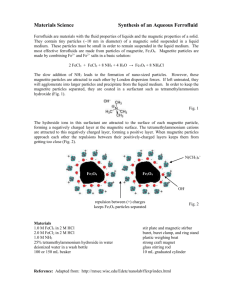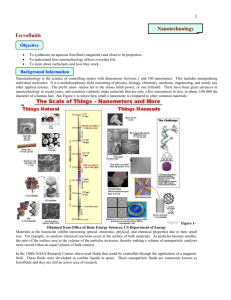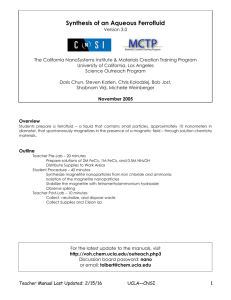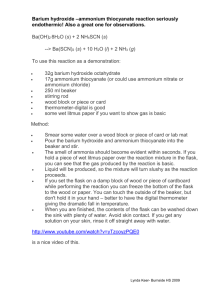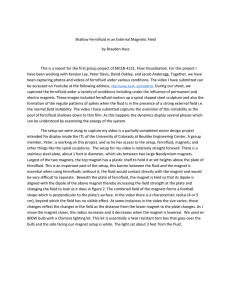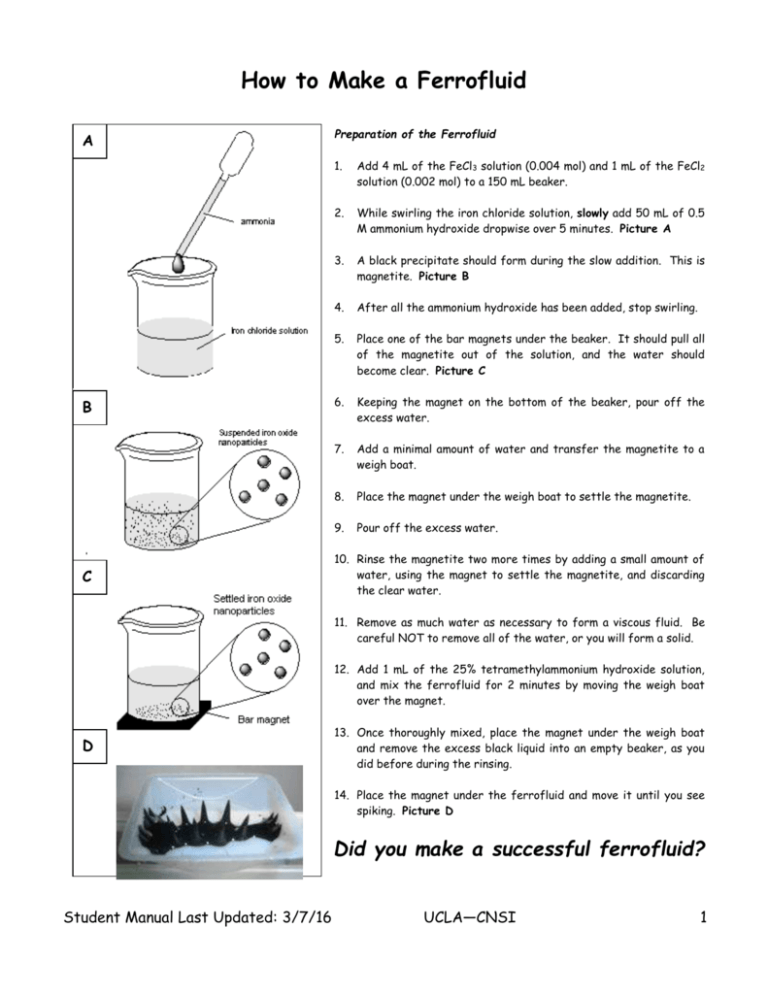
How to Make a Ferrofluid
A
B
C
Preparation of the Ferrofluid
1.
Add 4 mL of the FeCl3 solution (0.004 mol) and 1 mL of the FeCl2
solution (0.002 mol) to a 150 mL beaker.
2.
While swirling the iron chloride solution, slowly add 50 mL of 0.5
M ammonium hydroxide dropwise over 5 minutes. Picture A
3.
A black precipitate should form during the slow addition. This is
magnetite. Picture B
4.
After all the ammonium hydroxide has been added, stop swirling.
5.
Place one of the bar magnets under the beaker. It should pull all
of the magnetite out of the solution, and the water should
become clear. Picture C
6.
Keeping the magnet on the bottom of the beaker, pour off the
excess water.
7.
Add a minimal amount of water and transfer the magnetite to a
weigh boat.
8.
Place the magnet under the weigh boat to settle the magnetite.
9.
Pour off the excess water.
10. Rinse the magnetite two more times by adding a small amount of
water, using the magnet to settle the magnetite, and discarding
the clear water.
11. Remove as much water as necessary to form a viscous fluid. Be
careful NOT to remove all of the water, or you will form a solid.
12. Add 1 mL of the 25% tetramethylammonium hydroxide solution,
and mix the ferrofluid for 2 minutes by moving the weigh boat
over the magnet.
D
13. Once thoroughly mixed, place the magnet under the weigh boat
and remove the excess black liquid into an empty beaker, as you
did before during the rinsing.
14. Place the magnet under the ferrofluid and move it until you see
spiking. Picture D
Did you make a successful ferrofluid?
Student Manual Last Updated: 3/7/16
UCLA—CNSI
1
Discussion Questions
1.
What is the molarity of the FeCl3 and FeCl2 solutions?
2. Why do you think slow (dropwise) addition of ammonium hydroxide is important? What might happen
if you add the ammonium hydroxide quickly?
3. Magnetite, Fe3O4, consists of iron in what oxidation states?
4. Why do you place a magnet underneath the beaker while removing the water?
5. What is the purpose of the stabilizing agent tetramethylammonium hydroxide? What might happen
if NO stabilizing agent is used?
6. Describe what happens when a magnet is brought near a ferrofluid. What happens when the magnet
is removed from the ferrofluid?
7. ADVANCED: Balance the following equation.
__ FeCl3 + __ FeCl2 + __ NH3 + __ H2O → __ Fe3O4 + __ NH4Cl
Copyright © 2003 by Sarah Tolbert. All rights reserved; revised 2007
Student Manual Last Updated: 3/7/16
UCLA—CNSI
2

